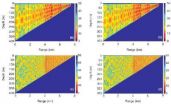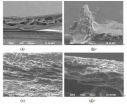(Press-News.org) A new analysis provides a closer look at how much cancer patients value hope — with important implications for how insurers value treatment, particularly in end-of-life care.
The analysis led by Darius Lakdawalla, director of research at the Schaeffer Center at USC and associate professor in the USC Price School of Public Policy, surveyed 150 cancer patients currently undergoing treatment, and is part of a special issue on cancer spending from the journal Health Affairs.
Lakdawalla and his co-authors found the overwhelming majority of cancer patients prefer riskier treatments that offer the possibility of longer survival over safer treatments: 77 percent of cancer patients said they would rather take a "hopeful gamble" — treatments that offer a 50/50 chance of either adding three years or no additional survival — to "safe bet" treatments that would keep them alive for 18 months, but no longer.
"Consumers tend to dislike risk, and researchers and policy makers have generally assumed that patients care about the average gain in survival," Lakdawalla said. "But patients facing a fatal disease with relatively short remaining life expectancy may have less to lose and be more willing to swing for the fences. This analysis points to the larger ideal — that value should be defined from the viewpoint of the patient."
John A. Romley, an economist with the Schaeffer Center at USC; Yuri Sanchez of health care consulting firm Precision Health Economics; Ross MacLean and John Penrod of Bristol-Myers Squibb; and Tomas Philipson of the University of Chicago and Senior Fellow at the Schaeffer Center at USC, were co-authors on the study.
The study is one of several in the special issue of the journal Health Affairs, sponsored by Bristol-Myers Squibb and the Schaeffer Center at USC, that look at cancer spending and assess the value of treatments which can cost thousands of dollars yet might offer patients with a terminal illness the hope of staying alive longer. Taken together, the articles provide additional considerations for policymakers, patients, providers and others as to when a high-cost treatment is 'worth' the price.
Other papers from the Schaeffer Center at USC in the issue of Health Affairs:
Tomas Philipson, Senior Fellow at the Schaeffer Center at USC and Daniel Levin Chair in Public Policy at the University of Chicago, and his coauthors, looked at the higher cost system of cancer treatment in the United States and compared it to care in ten European countries from 1983-1999.
The United States spends more on cancer care than European countries, but the analysis suggests that this investment also generates a greater 'value' for US patients who typically live nearly two years longer than their European counterparts.
For most cancer types, U.S. cancer patients lived longer than their European counterparts, according to the results in the Health Affairs paper. Cancer patients diagnosed from 1995 to 1999 lived 11.1 years after diagnosis in the United States, on average, compared to 9.3 years after diagnosis in Europe.
This analysis suggests that the higher-cost U.S. system of cancer care delivery may be worth it, say the authors, although further research is required to determine what specific tools or treatments are driving improved cancer survival in the United States.
Michael Eber of Precision Health Economics, Lakdawalla of the Schaeffer Center at USC, Mitra Corral of Bristol Myers-Squibb, Rena Conti of the University of Chicago, and Dana Goldman, director of the Schaeffer Center at USC and Norman Topping Chair in Medicine and Public Policy at USC, were co-authors of the study.
Healthy people are willing to pay more for generous coverage of high-cost drugs that treat cancer and other serious diseases, according to research led John A. Romley, an economist with the Schaeffer Center at USC and research assistant professor at the USC Price School of Public Policy.
On average, healthy people were willing to pay an extra $12.94 per month for better coverage of high-cost drugs. The cost of covering specialty drugs is about $5 per month—meaning respondents were willing to pay $2.58 in health care premiums for every dollar in out-of-pocket costs on a less generous insurance plan.
"If sick patients faced with the full cost of care decline to undergo treatment, one might conclude that these treatments are not "worth it"," Romley said. "But our study shows that healthy individuals apparently dislike the financial risk associated with future treatment enough to finance the average cost of coverage across all beneficiaries – indeed, they're willing to pay more than the actual cost for coverage, suggesting that the value they place on it exceeds what it costs to provide."
INFORMATION:
Sanchez of Precision Health Economics, Penrod of Bristol Myers-Squibb and Goldman of the Schaeffer Center at USC, were co-authors of the study.
The April issue of Health Affairs is supported by Bristol-Myers Squibb, the Schaeffer Center at USC and Precision Health Economics.
A full table of contents is available here: http://www.healthaffairs.org/Media/toc/2012_04_toc.pdf
To request a copy of a paper or to arrange an interview with the researcher, contact Suzanne Wu at suzanne.wu@usc.edu.
END
In the face of mass deforestation of the Amazon, recent findings indicate that we could learn from its earliest inhabitants who managed their farmland sustainably. An international team of archaeologists and paleoecologists, including Dr. Mitchell Power, curator of the Garrett Herbarium at the Natural History Museum of Utah and assistant professor in the Department of Geography at the University of Utah, report for the first time that indigenous people, living in the savannas around the Amazonian forest, farmed without using fire. These findings are published today, April ...
BOSTON – Contrary to popular perception, a large proportion of obese Americans can and do lose weight, say researchers at Beth Israel Deaconess Medical Center. What's more, they say, the old tried and true methods of eating less fat and exercising are some of the most effective paths to weight loss success.
The research results appear in the April 10 online issue of the American Journal of Preventive Medicine.
"This is great news because studies have shown that even a 5 percent reduction in weight can lead to improved health," says lead author Jacinda M. Nicklas, MD, ...
San Diego, CA, April 10, 2012 – A third of Americans are now obese, and up to 70% of them are trying to lose weight. In a new study published in the American Journal of Preventive Medicine, researchers from Harvard Medical School and Beth Israel Deaconess Medical Center in Boston have found in a nationally representative sample that obese dieters who said they ate less fat, exercised more, and used prescription weight loss medications were more likely to lose weight. Diet foods and products, nonprescription diet pills, and popular diets were less successful, according ...
People who received frequent dental x-rays in the past have an increased risk of developing the most commonly diagnosed primary brain tumor in the United States. That is the finding of a study published early online in Cancer, a peer-reviewed journal of the American Cancer Society. Although dental x-rays are necessary in many cases, these findings suggest that moderate use of this form of imaging may be of benefit to some patients.
Ionizing radiation is the primary environmental risk factor for developing meningioma, which is the most frequently diagnosed primary brain ...
The coupled normal mode method is a powerful approach for solving range-dependent propagation problems in underwater acoustics. An important area of study is to improve stability and efficiency so as to be able to deal with complex scenarios in a realistic environment. Professor LUO Wenyu and his group from the State Key Laboratory of Acoustics, Institute of Acoustics, Chinese Academy of Sciences, set out to tackle this problem. After several years of innovative research, they have developed an accurate, efficient, and numerically stable coupled normal mode method to solve ...
The Pharmaceutical Education and Research Institute (PERI) and PeerParty are pleased to announce the inaugural CME National Championship for the healthcare community. The Championship introduces a new approach to continuing education for healthcare practitioners - a fun, collaborative approach that rewards participants for learning and building their professional networks. This innovative approach employs a number of new techniques to challenge and reward participants, with the goal of positively affecting knowledge-sharing, learning and most importantly, improving patient ...
The bio-mechanisms of the woodpecker's resistance to head impact injury are an interesting scientific question. Professor FAN Yubo and his group from the Key Laboratory for Biomechanics and Mechanobiology of the Ministry of Education, School of Biological Science and Medical Engineering, Beihang University, and the School of Materials Science and Engineering, Wuhan University of Technology, set out to study this problem. After 3 years of innovative research, they are making progress in uncovering the explanation for the avoidance of head impact injury by woodpeckers. Their ...
San Diego, CA, April 10, 2012 – The neighborhoods in which children and adolescents live and spend their time play a role in whether or not they eat a healthy diet, get enough exercise or become obese, concludes a collection of studies in a special theme issue of the American Journal of Preventive Medicine.
Each of the six studies uses the latest concepts and methods in geographic information systems (GIS)-based research to determine how the geographic location affects physical health. A study titled "Spatial Classification of Youth Physical Activity Patterns" shows, ...
Psoriasis is a non-contagious, genetic disease of the immune system and manifests itself in the skin and/or joints of the body. It affects about 2% of the population or 7,500,000 people in the United States alone. Research is the top priority of The National Psoriasis Foundation, whose efforts are aimed at searching for better treatments and a cure for psoriasis.
"The National Psoriasis Foundation appreciates the dedication of our corporate partners who so willingly support our mission goal of research for a cure," says Eric Kimble, a Board of Trustee of the ...
In order for the nation to achieve goals set by the federal government for reducing obesity rates by 2020, children in the United States would need to eliminate an average of 64 excess calories per day, researchers calculated in a study published today in the American Journal of Preventive Medicine. This reduction could be achieved by decreasing calorie intake, increasing physical activity, or both. Without this reduction, the authors predict that the average U.S. youth would be nearly four pounds heavier than a child or teen of the same age was in 2007-2008, and more than ...



